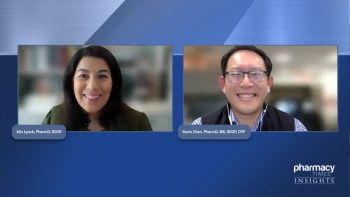
Utilizing BTK Inhibitors to Achieve Chemo-Free Therapy
This panel of experts navigates the effects of BTK inhibitors, and their impact on trpatients with Mantle Cell Lymphoma.
Episodes in this series

Ryan Haumschild, PharmD, MS, MBA: We talked about the concept of a chemotherapy-free regimen. Looking into the future, how can we provide therapies that provide a good quality of life and are less toxic, so patients can handle? That’s the exciting piece of clinical trials, but also leveraging innovative mechanisms of action in combining these targeted therapies. In that vein, I’d like us to talk about BTK [Bruton tyrosine kinase] inhibitors, because that’s an innovative area. When we think about BTK inhibitors, we obviously think about ibrutinib. It’s been around. There are a lot of clinical data there. There’s also acalabrutinib and zanubrutinib. We’re thinking about some of these first-generation and next-generation BTK inhibitors. Dr Jain, can you explain the differences and similarities of BTK inhibitors as a whole and how they play into the pathophysiology of mantle cell lymphoma?
Preetesh Jain, MBBS, MD, DM, PhD: This question can be answered in different ways, but BTK is a protein. It’s a large protein with almost 700 amino acids. This protein is called a Bruton tyrosine kinase. It’s like other cancers, where there’s a signal transduction pathway. It’s 1 of the important tyrosine kinases in the cells of mantle cell lymphoma, which is shown to have a very significant role in signaling the cell growth proliferation and survival.
The B-cell receptor is basically a receptor complex that has different subunits. Whenever there’s any antigen that’s promoting the signaling, it goes via the BTK. We’ve seen that if you block this enzyme, the intracellular signaling pathways are abrogated. Once they’re abrogated, the downstream propagation of these into the transcription factors is gone. Once that’s done, then the cell division growth proliferation—everything is affected. That’s how the BTK inhibitors were developed. Canine lymphoma models were the first, where Dr [Lee] Honigberg reported those.
Because the BTK enzyme is big, it can [resemble] some of the other enzymes present in our body, such as in the heart, pancreas, lymphocytes, and other areas and immune cells. When ibrutinib was discovered, it was identified to be blocking this big enzyme. But we were noticing some of the adverse effects from ibrutinib therapy over the long term. Then they went into developing more specific drugs, such as acalabrutinib and zanubrutinib, which are more selective and with fewer off-target effects. These 3 are the covalent innovators. That means they bind to the BTK protein and particular domains in a covalent manner. But whenever the BTK enzyme is recovered, these drugs become resistant. Although you have fewer adverse effects, the question comes about resistance. That’s why new BTK inhibitors, such as pirtobrutinib, have come into picture.
Dr Wang has led the major study on the pirtobrutinib, which is a major advancement in mantle cell lymphoma. They’re also reversible. In spite of a higher turnover rate, they can keep blocking by hydrogen bonds instead of the covalent bonds. That makes it quite unique and very well tolerated. This way, you develop the BTK inhibitors again into first generation, second generation, and now the new generation and third generation of agents. This is how it pans out.
Michael Wang, MD: In the past, patients came to our clinic and said, “Dr Wang, I don’t care what you do. Just get rid of my lymphoma.” These days, things have changed. The young people come here and say, “Dr Wang, I want you to get rid of my lymphoma without using chemotherapy.” All this therapy described by Dr Jain, with BTK inhibitors, covalent, and reversible, together with the other agents shall be combined as chemotherapy-free therapies to gradually replace chemotherapy so that we can reduce acute toxicity and the longer-term toxicities, such as secondary and primary malignancies, which will be a bigger problem in the future. We’re not only using chemotherapy-free therapies, we’re adding immunotherapies and CAR [chimeric antigen receptor] T-cell therapies. Our field has never been so exciting. Dr Jain and I work hard, but we’re also working hard with excitement.
Ryan Haumschild, PharmD, MS, MBA: Your passion for patient care comes through on this video. That’s what I wanted people to see: that innovation and great knowledge. You’ve explained how far we’ve come and how much further we want to take the therapeutic choices that are still out there. Dr Jain, you did a great job describing some of these BTK inhibitors. We’ll get back to some of the pathophysiology about the off-target effects on the heart, because that’s going to come into play as we talk about some of the management. But talk me through how BTK inhibitors changed the therapy and outcomes for patients with mantle cell lymphoma.
Preetesh Jain, MBBS, MD, DM, PhD: Recently, a Connecticut group from Yale [University] did a fantastic job of looking into patients who’ve been treated with BTK inhibitors across the United States. More than 3000 patients were reviewed, and they divided these patients between 2012 onward and prior to 2012, patients who haven’t gotten a BTK inhibitor—pre-BTK era—and those in the post-BTK era. Those patients were subdivided into different age groups. Clearly, there was an overall survival impact by using BTK inhibitors in patients between the ages of 70 and 80 years, with patients at least 65 years and older and up to 75 or 80 years old. In the multivariate analysis, this age group best benefited from improvement in the overall survival. That’s the major advancement in mantle cell lymphoma.
Ryan Haumschild, PharmD, MS, MBA: Dr Jain, as we think about these innovative products, are there patients who aren’t eligible for BTK inhibitors? How would you identify a patient like that during the course of therapy?
Preetesh Jain, MBBS, MD, DM, PhD: That’s a clinical scenario where we see that these patients are already having a very bad cardiac condition with advanced cardiac comorbidities. Clearly, we have to choose the BTK inhibitors very carefully for these patients because of the risk of cardiac arrhythmias or different patterns of cardiac arrhythmias, not only atrial fibrillation. There’s a different spectrum of cardiac arrhythmias described with the use of ibrutinib and the other BTK inhibitors. Compared with ibrutinib, the incidence of these adverse events is much less with the newer BTK inhibitors, such as acalabrutinib and zanubrutinib. But clearly, they’re also able to induce those adverse effects.
If the patients have those conditions, then we have to carefully discuss with the patient and get cardiologists to see these patients, get the loop event recorder, maybe get the abolition, and then carefully assess with the patient the need for anticoagulation, because bleeding tendency can also get worse. There’s an interaction of BTK inhibitors with the warfarin type of agent, so you have to look at direct-acting oral anticoagulants. These are the things that you have to carefully discuss with the patient in conjunction with the cardiology consultation. That’s a major comorbidity that you’d discuss.
The second comorbidity you’d discuss is hypertension. With long-term follow-up, ibrutinib-associated hypertension is an important thing that has come into the picture. You discuss optimal management of blood pressure with these patients. Those are the 2 common clinical scenarios. There’s bleeding tendency, as I mentioned, which can be also induced with acalabrutinib and zanubrutinib, but it’s more like superficial bleeding. Clearly, you have to weigh the cardio and vascular comorbidities together.
Ryan Haumschild, PharmD, MS, MBA: That was a great overview of those unique patients and what we should be on the lookout for. Not only who’s ineligible but what to monitor. I like how you touched on hypertension and tied it back to that pathophysiology.
Transcript edited for clarity.
Newsletter
Stay informed on drug updates, treatment guidelines, and pharmacy practice trends—subscribe to Pharmacy Times for weekly clinical insights.













































































































































































































